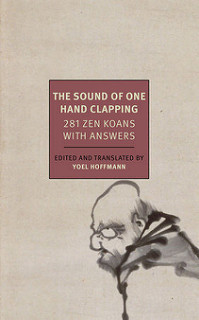NYRB Classics discussion

This topic is about
The Sound of One Hand
Book Discussions (general)
>
The Sound of the One Hand: 281 Zen Koans with Answers
date newest »
newest »
 newest »
newest »
I don't know a lot about this one yet. I see it around the internet as The Sound of One Hand Clapping: 281 Koans and Their Solutions, and that Yoel Hoffmann is the translator, not the author as Amazon's current listing has it. I don't know when the pieces were originally published yet.
If any of you have more information, feel free to share with any references you can provide. I'll supplement this as more becomes available.
If any of you have more information, feel free to share with any references you can provide. I'll supplement this as more becomes available.
Cover is now available! And with it comes some answers as to the title, so ignore my first comment which was based on a variant (and apparently incorrect) title and a listing that had Hoffmann as the author.
Okay, the description has been added, which helps explain a lot more that I was able to get just knowing the title.
The title has also changed to The Sound of the One Hand. See here the original cover with "The Sound of One Hand Clapping" (interestingly, the jacket copy has not changed yet).






Publication Date: November 22, 2016
Pages: 336
Translated by Yoel Hoffmann
Originally published in 1916.
Introduction by Dror Burstein.
When The Sound of One Hand Clapping came out in Japan in 1916 it caused a scandal. Zen was a secretive practice, its wisdom relayed from master to novice in strictest privacy. That a handbook existed recording not only the riddling koans that are central to Zen teaching but also detailing the answers to them seemed to mark Zen as rote, not revelatory.
For all that, The Sound of One Hand Clapping opens the door to Zen like no other book. Including koans that go back to the master who first brought the koanteaching method from Japan to China in the eighteenth century, this book offers, in the words of the translator, editor, and Zen initiate Yoel Hoffmann, “the clearest, most detailed, and most correct picture of Zen” that can be found. What we have here is an extraordinary introduction to Zen thought as lived thought, a treasury of problems, paradoxes, and performance that will appeal to artists, writers, and philosophers as well as Buddhists and students of religion.